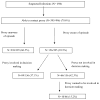Healthcare Proxy Awareness of Suspected Infections in Nursing Home Residents with Advanced Dementia
- PMID: 26031905
- PMCID: PMC4478162
- DOI: 10.1111/jgs.13435
Healthcare Proxy Awareness of Suspected Infections in Nursing Home Residents with Advanced Dementia
Abstract
Objectives: To determine healthcare proxy involvement in decision-making regarding infections in individuals with advanced dementia.
Design: Prospective cohort study.
Setting: Thirty-five Boston-area nursing homes (NHs).
Participants: NH residents with advanced dementia and their proxies (N = 362).
Measurements: Charts were abstracted monthly (up to 12 months) for documentation of suspected infections and provider-proxy discussions for each episode. Proxies were interviewed within 8 weeks of the infection to determine their awareness and decision-making involvement. Factors associated with proxy awareness and discussion documentation were identified.
Results: There were 496 suspected infections; proxies were reached for interview for 395 (80%). Proxy-provider discussions were documented for 207 (52%) episodes, yet proxies were aware of only 156 (39%). Proxies participated in decision-making for 89 (57%) episodes of which they were aware. Proxy awareness was associated with antimicrobial use (adjusted odds ratio (AOR) = 3.43, 95% confidence interval (CI) = 1.94-6.05), hospital transfer (AOR = 3.00, 95% CI = 1.19-7.53), infection within 30 days of death (AOR = 3.32, 95% CI = 1.54-7.18), and fewer days between infection and study interview (AOR = 2.71, 95% CI = 1.63-4.51). Discussion documentation was associated with the resident residing in a dementia special care unit (AOR = 1.71, 95% CI = 1.04-2.80), the resident not on hospice (AOR = 3.25, 95% CI = 1.31-8.02), more provider visits (AOR = 1.71, 95% CI = 1.07-2.75), proxy visits of more than 7 h/wk (AOR = 1.93, 95% CI = 1.02-3.67), and episode within 30 days of death (AOR = 3.99, 95% CI = 1.98-8.02).
Conclusion: Proxies are unaware of and do not participate in decision-making for most suspected infections that NH residents with advanced dementia experience. Proxy awareness of episodes and documentation of provider-proxy discussions are not congruent.
Keywords: dementia; nursing home; surrogate decision-making.
© 2015, Copyright the Authors Journal compilation © 2015, The American Geriatrics Society.
Conflict of interest statement
Figures


References
-
- National Center for Health Statistics. [Accessed February 19, 2013];National Vital Statistics Reports. 2012 61(6) http://www.cdc.gov/nchs/data/nvsr/nvsr61/nvsr61_06.pdf.
-
- Smith GE, Kokmen E, O’Brien PC. Risk factors for nursing home placement in a population-based dementia cohort. J Am Geriatr Soc. 2000;48:519–525. - PubMed
-
- Mitchell SL, Teno JM, Miller SC, et al. A national study of the location of death for older persons with dementia. J Am Geriatr Soc. 2005;53:299–305. - PubMed
-
- Maust DT, Blass DM, Black BS, et al. Treatment decisions regarding hospitalization and surgery for nursing home residents with advanced dementia: The CareAD Study. Int Psychogeriatr. 2008;20:406–418. - PubMed
Publication types
MeSH terms
Substances
Grants and funding
LinkOut - more resources
Full Text Sources
Other Literature Sources
Medical

